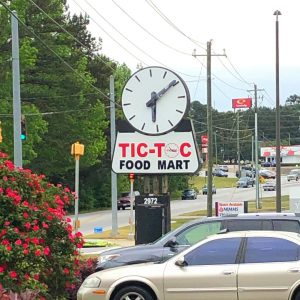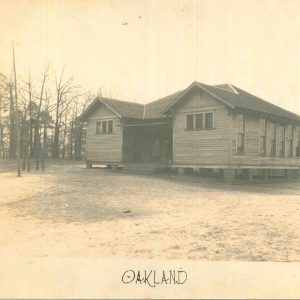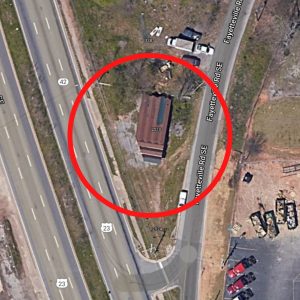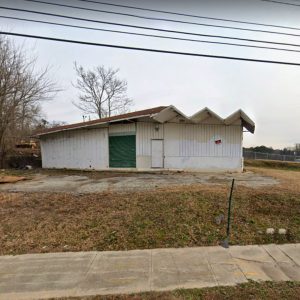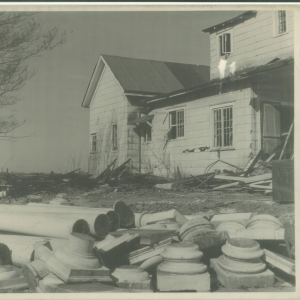Fall 2021 Mini Posts
First Federal Bank Branch
What is now the Tic Tok Food Mart on Evans Mill Road was originally built as a First Federal Bank Branch (First Federal Savings and Loan Association). Their headquarter building in Atlanta (40 Marietta Street) was built in 1964 and set the modern tone for their branches that had amazing variety and flair. Each branch had a clock out front, and Tik Tok uses theirs in conjunction with its branding. We think our DeKalb branch could be classified as Brutalist – what do you think? The choice of materials are Brutalist: concrete, brick and glass, and we love this modern take on flying buttresses and clerestory windows!
Hill Climbs- Buena Vista Hill and Stone Mountain
Oakland School- DeKalb County
Tastee-Freeze, Moreland Ave
A&W Drive In, 5099 Memorial Drive
A&W Drive-In, ca.1973, 5099 Memorial Drive
A&Ws were known for their all American food, and family friendly environment. Many early A&Ws had a carhop service under a canopy, although this location most likely just had a drive through window.
Colloquially called a pilgrim hat, the pagoda style roof replaced the original box design used in the 1950s-60s. The first pagoda style building was designed and manufactured by the Trachte Brothers Company in 1965 for an A&W franchise in Edgerton, Wisconsin. All roofs were steel, however this DeKalb Country version deviates with an asphalt roof. Additionally, most A&Ws from this era were square while ours is octagonal. The recognizable roof is distinctive: a welcome sight for many families on long road trips. Each location featured a round fireplace in the center of the dining room that accentuated the “finial” in the center of the roof. Some locations had a bar around the fireplace. One location in Casper, Wyoming, even had an aquarium.
One can only think of the “family friendly” environment sitting at a bar around a warm stone fireplace drinking root beer out of a frosted mug.
A&W tried to enter the Atlanta market with franchise opportunities in 1973, although only one other was built at 1801 Savoy Dr. Corporate changes and massive growth from other food chains put pressure on A&W and many A&W franchises were unable to compete. By 1980 this structure had become The Original Pancake House.
Some original A&Ws still exist, complete with their working fireplaces. If you find yourself on a road trip through the Midwest and see an orange pagoda, consider having a draught root beer in a frosted mug at this iconic restaurant.
Creek and Cherokee Nation- DeKalb County
Georgia was once the ancestral homeland to both the Cherokee Nation and the Creek Nation, but by the early 19th century, their land became seriously threatened by incoming settlers. The Creeks, Cherokees, and Choctaws, along with other southeastern tribes, all descended from the peoples of the Mississippian period (circa AD 800-1500).
The Creek Confederacy, now known as the Creek Nation, consisted of a union of several groups. They lived in tribal towns all through middle and south Georgia and in Alabama. The English differentiated the groups by location, calling those who lived in towns on the Coosa and Tallapoosa rivers, the Upper Creeks, and those who lived on the Chattahoochee and Flint rivers, the Lower Creeks.
For centuries, the Cherokee Nation inhabited parts of northern Georgia and Alabama, southern Tennessee, and western North Carolina. Today, the largest group of Cherokees live in northeastern Oklahoma. Two other federally recognized tribes are the United Keetoowah Band of Cherokee Indians in Oklahoma and the Eastern Band of Cherokee Indians in North Carolina.
The Creek Confederacy’s western descendants are known as the Muscogee (Creek) Nation today, located in Okmulgee, Oklahoma. The Seminole Tribe of Florida and the Poarch Band of Creek Indians in Alabama are federally recognized tribes who stem from the Creek Nation and who, fortunately, were not removed from their ancestral lands.
The contributions of the Creek Nation and Cherokee Nation can still be seen in DeKalb County today. Numerous railways, roads and paths, including the path up Stone Mountain, still follow the trails and intersections carved out hundreds of years ago by the Indigenous Peoples of this land.
An in depth blog post is forthcoming that will cover the violent removals of the Indigenous People from their homelands across the state.




